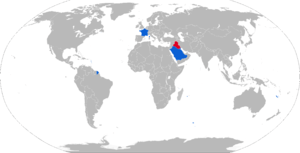GCT 155mm
| GCT 155mm | |
|---|---|
|
GCT 155mm self-propelled artillery of the French Army | |
| Type | Self-Propelled Artillery |
| Place of origin | France |
| Service history | |
| In service | 1977 – present |
| Used by | Saudi Arabia, Iraq and France |
| Production history | |
| Designed | 1972 |
| Manufacturer | Nexter |
| Produced | 1977 – 1995 |
| Number built | 400 |
| Specifications | |
| Weight | 41.949 tonnes |
| Length | 10.25 m |
| Width | 3.15 m |
| Height | 3.25 m |
| Crew | 4; Commander, Driver, Gunner and Loader |
|
| |
| Armor | 20 mm |
Main armament | One 155 mm howitzer |
Secondary armament | One 7.62mm or 12.7mm anti-aircraft machine gun |
| Engine |
Hispano-Suiza HS 110 12-cylinder water-cooled multi-fuel engine. 720 hp |
| Suspension | torsion bar |
Operational range | 450km |
| Speed | 60 km/h on-road. |
The GCT 155mm is a French self-propelled artillery vehicle currently in use by the armies of France and Saudi Arabia. It replaced the former Mk F3 155mm in French Army service. The GCT 155mm's primary advancement is that it incorporates and provides full armor and nuclear-biological-chemical (NBC) protection for its crew of four, while the former Mk F3 155mm offered no protection and could carry only two of its four crew members. Though 60% heavier than the American M109, the GCT 155mm is faster, fires faster and incorporated a more sophisticated fire control system. The GCT 155mm saw combat with the Iraqi Army in the Iran–Iraq War.
History
Though the French Mk 3 155mm would remain in production through the 1980s, by the early 1970s the French Army realized there was an urgent need for its replacement. The Mk. 3 155mm lacked a traversable turret and nuclear-biological-chemical (NBC) protection for its crew, and could carry only two of the four crew members needed to operate it (the remaining two having to be transported in support vehicles). Development of the GCT 155mm began in the early 1970s, and the first production version, known as the AUF1, was introduced in 1977. About 400 have been produced, with 70 having been upgraded to the AUF2 variant.
AUF1
The GCT 155mm AUF1 is based on the AMX-30 main battle tank (MBT) chassis and equipped with a 155mm 39-caliber gun with an auto-loading system, giving a rate of fire of 8 rounds per minute, and a sustained rate of fire of 6 rounds in 45s. It is also equipped with a roof-mounted 12.7mm anti-aircraft gun. The AUF1 has an effective range of 23,500 meters firing conventional rounds and 28,000 meters using Rocket Assisted Projectiles (RAPs).
The first production AUF1s were delivered exclusively to the Saudi Arabian Army, while the French Army received their first deliveries in 1980, deploying the GTC 155mm AUF1 in regiments of 18 guns each. In addition, the Iraqi Army received a small number of GTC 155mm AUF1 variants in 1980, which they employed during the Iran–Iraq War.
Operational history
A battery of 8 AUF1s from the French Army's 40em Regiment d'Artillerie was deployed in support of the Rapid Reaction Force on Mount Igman during the 1995 NATO bombing campaign in Bosnia and Herzegovina. The battery provided rapid counter-battery fire against Serb artillery units during the siege of Sarajevo, the long range of its guns allowing it dominate the surrounding terrain.
AUF2
The AUF2 is an improved turret for the GCT 155mm designed and built by GIAT. The AUF2 155mm howitzer and turret are designed for integration onto a wider range of armored chassis such as AMX30, Leopard 1, Arjun and T-72. It was initially developed to upgrade the 155mm GCT AUF1 self-propelled howitzers then in service with the French Army. The French Army has procured approximately 70 AUF2 turrets and mounted them on the AMX30B2 chassis.
Improvements in the AUF2 include an all-new automatic round and charge feed system and a new 52-caliber artillery tube. New charges and rounds are also available for the AUF2. The AUF2 is equipped with a 7.62mm anti-aircraft machine gun located at the roof of the turret. The AUF2 turret, including the gun and loading systems, weighs nearly 19 tons. Compared with the AUF1, the AUF2 offers a significantly improved range of 42 km, a higher rate of fire of 10 rounds/minute and multiple rounds simultaneous impact. In use, the weapon system has been found to have greater reliability, accuracy and ease of maintenance.
Operators

Current operators
 France - 253 unit (70 upgraded to AUF2)
France - 253 unit (70 upgraded to AUF2) Kuwait - 18 units
Kuwait - 18 units Saudi Arabia - 51 units
Saudi Arabia - 51 units
Former operators
 Iraq -[1] 85 received between 1983-1985, derelict after the 2003 invasion of Iraq.
Iraq -[1] 85 received between 1983-1985, derelict after the 2003 invasion of Iraq.
Notes
References
| Wikimedia Commons has media related to AuF1. |
- Trewhitt, Philip (1999). Armored Fighting Vehicles. New York, NY: Amber Books. p. 116. ISBN 0-7607-1260-3.